Day 14 - Sunday 9/25/05
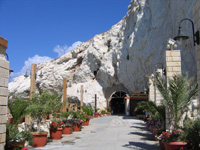
|
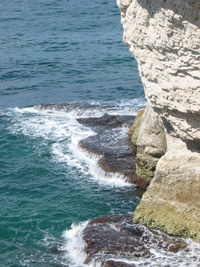
|
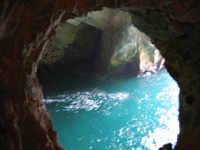
|
Rosh Hanikra
This morning's destination was Rosh Hanikra, the northwestern most point in Israel on the border with Lebanon. This location has always served as a passage point for trade caravans and armies passing from Lebanon and Syria to Israel, Egypt, and Africa. Alexander the Great built the first tunnel through the chalk cliffs for his army, and the British dug a larger tunnel during WWII for their Haifa - Beirut railway. In 1948, during the War for Independence, the Palmach blew up the railway bridges to thwart a possible invasion by the Lebanese army. The landscape is a white chalk cliff studded with flint nodules, extending into the sea. The grottos are cavernous tunnels formed by the action of the sea on the soft chalk. A manmade tunnel was constructed to connect the grottos and allow pedestrian access. We took a cable car down to the beach and explored the natural beauty of the area.
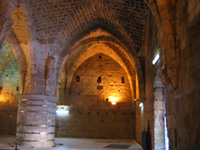
|
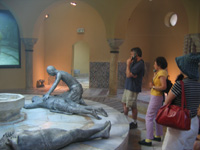
|
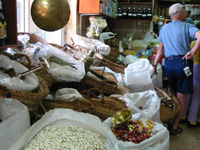
|
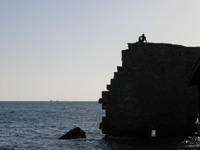
|
Akko
Our next stop heading south along the coast was the ancient city of Akko, also known as Acco or Acre. It was first settled in 1500 BCE and has changed hands often throughout its history. Here is a quote from the brochure: "The walls of the city, its fortresses and citadels, its churches and mosques and the other buildings within its boundaries, tell the history of the many rulers who governed it and fought for it, who built the city and glorified it. Acre's most prominent sites include ruins from the Hellenistic-Roman period and buildings from the Crusader and Ottoman periods: Al Jazar Mosque, the buildings of the Order of Saint John, the subterranean Crusader city, Khan Al Omdan, and the Turkish Baths. In Acre you will be able to see the fingerprints of many peoples and religious movements: the Canaanites, the Greeks, the Romans, the Byzantines, the Crusaders, the Mamelukes, the Turks and the British. Acre's colorful Oriental markets, the city walls, the museums, the beaches, and the restaurants are a few more of the city's tourist attractions." A few interesting tidbits from the city's history: In 1799, Napoleon tried to take over the city and was repulsed by the Turks after a two-month siege - his only defeat in his campaign against the Ottoman Empire. During the British Mandate, the Citadel was used as a prison for political prisoners. In 1947, the Irgun broke into the prison and succeeded in releasing 27 of the activists held there. Foreign journalists described it as "the greatest jail break in history." We particularly enjoyed our tours of the Ottoman Citadel, the Turkish Hamam (Bath), and the subterranean Crusader city including the Templar Tunnel which we used as a shortcut across town several times. The souk market was very colorful as well, and we spent time in a spice vendor's stall purchasing zatar (a middle eastern spice mix) and brass spice grinder, and the vendor threw in a bag of peppercorns for free.
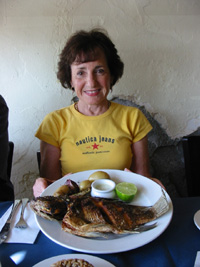
Lunch was at a local restaurant on the water. My mother finally had the fish she had been craving - served whole, fried and then baked. John and I sampled a locally caught variety, filleted. My father, who does not eat fish, enjoyed a delicious dish of mushrooms in cream sauce with rice.
Visit with Yona & Rifka
Back at Asia and Gideon's home, we enjoyed a desert of Turkish halva with Yona Yahav (the Mayor of Haifa) and his wife Rifka. They are good friends of the Levitas and have become acquainted with my family over the years - in fact we spent several days with them in Paris many years ago. It was good to catch up.
<<--- Yesterday |
Tomorrow --->> |
| Copyright © 2005 by Oreet Herbst and John Knott |